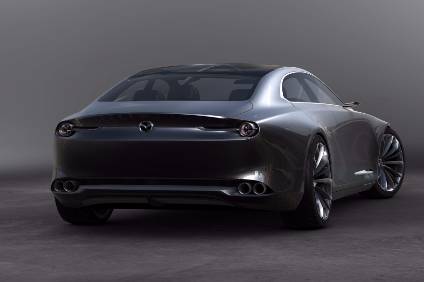
When Mazda broke off its relationship with Ford some 10 or more years ago the brand had to come up with a new design direction of its own – and so in 2010, its new design philosophy: Kodo —Soul of Motion was born.
Head of design Ikuo Maeda said the car has to be more than just a means of transport or a mass of metal. "It should be a vital presence in people's lives, like a friend or family member. That's why the Kodo design philosophy is all about breathing life into the very form of our cars."

Discover B2B Marketing That Performs
Combine business intelligence and editorial excellence to reach engaged professionals across 36 leading media platforms.
The first Mazda to encompass Kodo design was the CX-5 in 2010 and its has been rolled out through the range over the past seven years. But it's time to move on.
Mazda's sleek Vision Coupe is the next step, developed by all three of the company's design studios in Japan, the US and Germany. The key words for this model are simplicity and movement.
European design chief, Brit Kevin Rice explained: "The lines look simple but then you walk around the car or see it moving down the street you start seeing different shapes."
This effect comes from the Vision Coupe's concave side body panels which actually reflect the environment around it in a different way. Rice added: "While we appear to have kept the car simple and minimalistic that does not mean less is more. This was actually quite a complex operation, sculpting first in clay then digitizing the design to see if the reflections work – then it was back to clay and the process was repeated over and over again. The fine tuning took two years.
"Concave panels can look dead and you have to be aware that the image they reflect will be upside down. We worked on controlling the negative reflections to achieve a positive form of motion."
Maeda and Rice and their teams are already working on the next phase of Mazda design, but in the meantime the next stage of Kodo design will gradually be rolled out. Part of this is also evident in Mazda's second show car the Kai which shows how the new design philosophy could transfer to a production model. Rice insisted, however, that this is a show car and not a new RX7.
Rice said that it is important that all the design studios work together as Mazda's are not country specific, the same cars sell in all its markets. However, some things do not change, the five point grille on the front of the Vision Coupe has actually been around since the 1990s and has become something of a Mazda signature.
Maeda said: "For the coming generation of Mazda vehicles, we are creating a look that is even more elegant than anything seen before. We have set out a design philosophy which encapsulates a distinctively Japanese kind of beauty.
The Japanese aesthetic typically expresses a kind of elegance that is found nowhere else. This could be described as a style which grows out of an exquisite sense of balance—beautifully restrained, with nothing overemphasised. Much of Japanese traditional culture is based on the minimalist concept of "less is more," where the emphasis is on removing or minimising elements to create an abundance of empty space.
"With the Vision Coupe we have moved the cabin further back to form a single smooth line, based on the "golden ratio" of classic coupe proportions. The silhouette creates the feel of a high-performance machine, with a hint of powerful forward momentum. The focus has been on stripping away everything that is unnecessary."
Maeda added that with the interior, the design applied the concept of ma (literally "space" in Japanese), a distinguishing feature of traditional Japanese architecture. "The impression is of a space that reaches ahead as the car navigates the road. Structural forms such as the center console, door trim and instrument panel intersect with one another without touching, creating a sense of ma inside the car. The spaces that are created encourage the flow of air throughout the car, and the three-dimensional framework makes occupants feel safe without any sense of confinement.
"Car interiors have come to be dominated by large displays. Although considerable amounts of information need to be supplied to the person operating the car, these screens can easily become a barrier that blocks the driver's view. This model features a see-through screen developed by Mazda; it functions as a display only at those times when it is required, creating an interior space with perfect visibility for the driver's needs."




